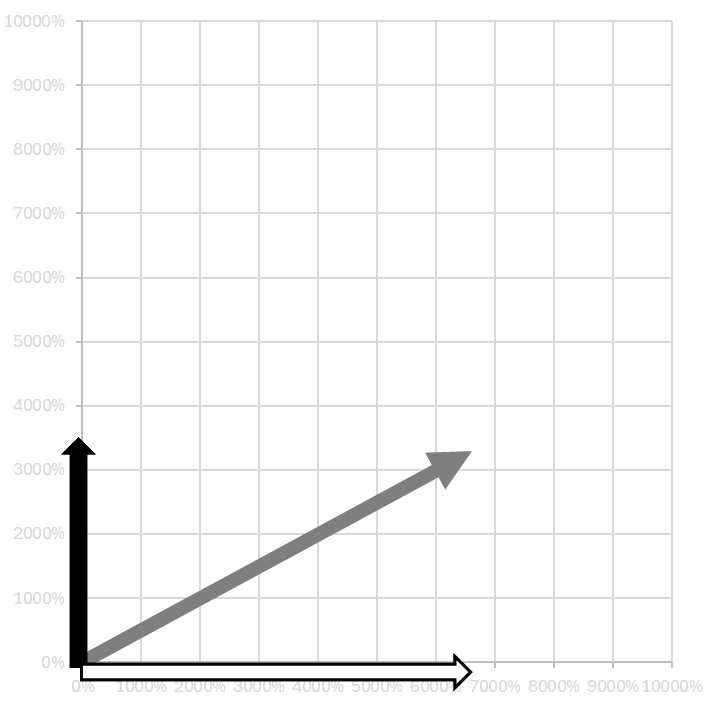8 PRIME IDENTITIES – A construction from MaxEnt Informational Efficiency in 4 questions
post by P. João (gabriel-brito) · 2025-04-16T16:53:51.351Z · LW · GW · 0 commentsContents
THE UNIVERSAL GOAL: USEFUL INFORMATION AND EFFICIENCY Is there a variable more universal to human function than information? This combination of information — illustrated by the gray arrow in the figure bellow — represents the effort to integrate, organize, and give meaning to many variables that, by themselves, could become an overwhelmingly complex system. THE 4 RELATED QUESTIONS 1. Focus on the environment or on oneself? 2. Elemental or individual? 3. Individual or informational? 4. Informational or social? HUMAN FUNCTIONS AND IDENTITIES RESULTS CONCLUSIONS REFERENCES None No comments
We experience phenomena that, while grounded in measurable substrates — like neural patterns, memories, or external stimuli — emerge as wholes that cannot be reduced to the sum of their parts (e.g., learning a new identities).
This document introduces an analytical tool that draws on information-theoretic principles Informational Efficiency under MaxEnt Constraints [1, 2] to examine human processes, starting from the hypothesis that it is possible to "break down" a human being into a system of interacting variables — physiological, emocional, symbolic and social [4, 5, 6].
The goal of this framework is not to compare individuals, but to enable self-evaluation through probabilistic lenses: to answer the question, “Am I more capable today of generating useful information than I was yesterday — and why?”
Binary distinctions such as internal vs. external, or elemental vs. individual, are used not as rigid categories, but as navigational heuristics within a continuous and entangled field of human experience.
Of course, life resists full reduction to any single metric. But perhaps a slightly more precise metaphor can help spark deeper self-insight.
THE UNIVERSAL GOAL: USEFUL INFORMATION AND EFFICIENCY
Is there a variable more universal to human function than information?
Rooted in Maximum Entropy informational efficiency, we view the human being as a system that organizes, transforms, and propagates information—not as a passive physical body subject to chaos, but as an active agent refining its own informational processes. (Just as shadow doesn't exist, only the absence of light, chaos doesn't exist.)
The MaxEnt informational efficiency of a complex system is its ability to reorganize or generate useful information for itself (self‑updating) or for its environment (interaction), by maximizing subjective entropy under cognitive, contextual, or physiological constraints.
In this sense, the human being could be the most refined known entity for combining useful information that we know. Our attention, memory, language, and cultural tools allow for recursive information loops — we not only act, but learn from action; not only think, but think about thinking.
However, due to the multiplicity of variables, extracting useful information can be a challenge. That is why it becomes essential to formulate guiding questions that reduce the number of variables, allowing us to better organize and update what matters.

In other words, we need a universal vector of informational efficiency, a clear direction to focus our attention and maximize informational efficiency under constraints.
Useful information: information that enhances our future capacity to generate, integrate, or apply more information — efficiently, given our cognitive, energetic, and contextual limitations. (e.g., a habit that leads to faster learning)
This combination of information — illustrated by the gray arrow in the figure bellow — represents the effort to integrate, organize, and give meaning to many variables that, by themselves, could become an overwhelmingly complex system.

*If it is difficult to visualize the universe as just a passive system, imagine it as an entity that seeks to combine information. In this scenario, the human being is configured as the most refined tool known for combining information – a metaphor that, albeit simplified, provides a parameter for motivation and understanding the proposed process.
Within this framework, the human being becomes the most refined tool for combining useful information, creating recursive loops: we act, learn, and refine both our internal structure and our external interactions. Consider, for example, identifying one area of your life where you could deliberately measure and improve your own informational efficiency — whether in decision-making, relationships, or habits of thought.
THE 4 RELATED QUESTIONS
Which question could break down the universal vector of human complexity into two factors?
Starting from the universal vector of information combination, we need questions that decompose the vector and weight it in terms of the probability of each level of combining information. Note that these are probabilistic questions relative to comparing the individual with oneself, not with others – a self-assessment rather than a comparison between individuals.
1. Focus on the environment or on oneself?
n any system, actions can alter both the system itself (input) and its surroundings (output). This distinction can break down the universal vector by determining the focus chosen when evaluating an objective, routine, or task.
For instance, the act of eating tends to provoke more internal changes (by generating energy and altering one’s context) than the act of hunting, which, although also complex, might be seen as more oriented towards external transformation.
This leads to the question:
“At this moment, is my focus on transforming myself or on modifying my environment?”
Although these changes occur simultaneously in practice – since changing oneself often alters the environment and vice versa – identifying the predominant focus can be fundamental to guide analysis and action.
Thus, the universal objective of combining information splits into two vectors:
x: Internalization, focused on personal change (represented by black arrows).
y: Externalization, geared towards altering the surrounding environment (represented by white arrows).


Represented below by the black and white arrows.
2. Elemental or individual?
*Universal Vector
Re-examining the universal vector, we then ask if the focus is more on combinations of elemental information (physiological/genetic/epigenetic) with the environment, or on individual-specific information, i.e., one's personal memory.
In other words, the question would be:
“At this moment, is my focus more on elemental interactions with the environment, or on personal (individual) information?”
For example, the act of eating might be interpreted as behavior aligning largely with the common objectives of the species – system maintenance at a genetic level – while more artistic actions, like singing, could be linked to an expression of personal and subjective nuances.
Then we can level the universal vector into two levels, as below:

3. Individual or informational?
Within the realm of individual information combinations, we can define another layer in which the objective is to combine personal memories and information. The question here becomes:
“Is my focus at this moment more on interrelating my own information or on establishing relationships between myself and the environment?”
For example, when studying mathematics, the focus might be more on combining information, whereas when singing it might be on personal expression.
Then we can level into two more 3 areas the universal vector, as below:

4. Informational or social?
Finally, within the “informational” category we further differentiate whether the focus is on combining pieces of information internally or on communicating that information and relating to other complex individuals.
The corresponding question becomes:
“At this moment, is my focus more on generating information or on cooperating?”
For instance, when speaking with one’s boss, the focus might lean more towards relating with another complex being than merely on information synthesis.
Then we can level out in two more 4 areas the universal goal, as below:


HUMAN FUNCTIONS AND IDENTITIES
We start from the universal objective of combining useful information. We decompose this “mega-vector” into x/y (input/output) and four areas:
- Elemental (genes ↔ environment)
- Individual (personal memory ↔ genes)
- Informational (memory ↔ memory)
- Social (informational ↔ collaboration)
Each area generates two SubVectors: input focus (x) and output focus (y), totaling eight vectors.


Names are given to these sub-objectives along with a corresponding score to be applied in one’s life. It is important to note that these metrics are self-assessments and inherently subjective. The numbers are used as relative references (for example, “Compared to my last month, or comparing specific moments: am I more focused on X?”). The labels serve as metaphors rather than strict scientific definitions. For instance, at the elemental level, one might aim to be more receptive or more active – focusing on eating well or exercising might be reflective of such contrasts. As below:

To confirm the meaning of the levels, we can also see some relationships with evolutionary psychology, as follows:

And we can name related identities needed for these goals, and illustrate with some totems, insects for inward identities, animals for outward identities, cool colors for inward identities, warm colors for outward identities: As figure bellow:

And a final summary table:

RESULTS
With these parameters, one can formulate questions for special moments in life to help organize events, routines, and tasks. This approach comes closer to the atomic model where, even though we might not precisely pinpoint an electron’s layer, through specific questions we can predict which area our focus lies in. As the diagram below shows:

Thus, having a slightly more accurate assessment of objectives, routines and tasks. In addition to making a more accurate diary template like the one proposed here [LW · GW].
CONCLUSIONS
We have thus defined probabilistic identities. The apparent dichotomy serves as an analytical tool rather than an absolute division. In practice, these categories merge—indeed, by affirming that “by changing oneself one changes the environment.”
A linear simplified construction in:
8-probabilistic-skills-a-construction-from-maxent [LW · GW]
A specific more application in:
gamify-life-from-bayesianmind [LW · GW]
Your feedback is welcome!
If you have suggestions, critiques, or experiences to share, feel free to comment publicly or send me a private message. Every perspective helps refine the tool and make it more useful.
REFERENCES
- 1, Jaynes, E. T. (1957). Information theory and statistical mechanics. Physical Review, 106(4), 620–630.
- 2 Jaynes, E. T. (1985). Where do we stand on maximum entropy? In: Levine, R. D., & Tribus, M. (Eds.), The Maximum Entropy Formalism. MIT Press.
- Smith, E., & Morowitz, H. J. (2016). The Origin and Nature of Life on Earth: The Emergence of the Fourth Geosphere. Cambridge University Press.
→ Discuten cómo la información y la termodinámica se relacionan en sistemas biológicos. - Friston, K. (2010). The free-energy principle: a unified brain theory? Nature Reviews Neuroscience, 11(2), 127–138.
→ Aunque habla de “free energy” y no de MaxEnt directo, se basa en minimizar sorpresa/información libre: una idea prima hermana de tu enfoque. - Caticha, A. (2012). Entropic inference and the foundations of physics. → Aplica MaxEnt como principio epistemológico general.
0 comments
Comments sorted by top scores.











